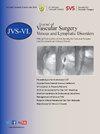细菌纤维素膜在静脉曲张手术中的应用:一项随机临床试验。
IF 2.8
2区 医学
Q2 PERIPHERAL VASCULAR DISEASE
Journal of vascular surgery. Venous and lymphatic disorders
Pub Date : 2025-08-20
DOI:10.1016/j.jvsv.2025.102302
引用次数: 0
摘要
背景:慢性静脉功能不全在世界各地都很常见。它常与下肢静脉曲张有关。手术治疗在大多数情况下是必要的,但手术伤口的处理仍然是一个挑战。目前,对于何种敷料是治疗OW的理想敷料尚未达成共识,但期望其具有低成本、低致敏性和良好粘附性等特点。目的:在这项研究中,一种满足所有这些特征的材料,细菌纤维素膜,在接受静脉曲张手术的患者中进行了评估。方法:随机前瞻性临床试验于2023年5月至2024年9月在医院血管外科Clínicas / EBSERH - UFPE进行。该研究包括55名接受静脉曲张手术的患者,分为两组:实验组使用细菌纤维素膜覆盖微切口,对照组使用微孔胶带。术后第4天至第6天,采用南安普敦伤口评估量表评估患者的疼痛、瘙痒和伤口外观。这些组在所有人口统计数据、合并症的存在和CEAP临床分类上都是相同的。结果:对照组拔牙时疼痛更频繁,平均评分为3.46 (+/- 3.26),p组为0.63(+/- 1.38)。结论:两组患者在瘙痒和创面愈合方面无统计学差异。细菌纤维素膜显示出与微孔胶带相容的愈合效果,并且具有去除时产生较少疼痛的优点。本文章由计算机程序翻译,如有差异,请以英文原文为准。
Application of bacterial cellulose film as a wound dressing in varicose vein surgery: A randomized clinical trial
Background
Chronic venous insufficiency is common all over the world. It is often related to lower limb varicose veins. Surgical treatment is necessary in most cases but the management of the operative wounds remains a challenge. Nowadays, there is no consensus on which is the ideal dressing for covering operative wounds, but features such as low cost, hypoallergenicity, and good adherence are expected. In this study, a material that meets all these features, the bacterial cellulose film (BCF), was evaluated in patients who underwent varicose vein surgery.
Methods
A randomized, prospective clinical trial was carried out at the Angiology and Vascular Surgery Department of the Hospital das Clínicas/EBSERH - UFPE, from May 2023 to September 2024. The study included 55 patients who underwent varicose vein surgery, divided in two groups: an experimental group, which used a BCF to cover microincisions, and a control group. which used microporous tape. Between postoperative days 4 and 6, patients were assessed for pain, itching, and wound appearance using the Southampton Wound Assessment Scale. The groups were homogeneous in all demographic data, presence of comorbidities, and Clinical-Etiology-Anatomy-Pathophysiology Clinical classification.
Results
Pain on removal was more common in the control group with a mean scale score of 3.46 ± 3.26 compared with 0.63 ± 1.38 (P < .001).
Conclusions
There was no statistical difference between the groups in itching and wound healing. BCF showed healing results comparable with microporous tape, with the advantage of generating less pain on removal.
求助全文
通过发布文献求助,成功后即可免费获取论文全文。
去求助
来源期刊

Journal of vascular surgery. Venous and lymphatic disorders
SURGERYPERIPHERAL VASCULAR DISEASE&n-PERIPHERAL VASCULAR DISEASE
CiteScore
6.30
自引率
18.80%
发文量
328
审稿时长
71 days
期刊介绍:
Journal of Vascular Surgery: Venous and Lymphatic Disorders is one of a series of specialist journals launched by the Journal of Vascular Surgery. It aims to be the premier international Journal of medical, endovascular and surgical management of venous and lymphatic disorders. It publishes high quality clinical, research, case reports, techniques, and practice manuscripts related to all aspects of venous and lymphatic disorders, including malformations and wound care, with an emphasis on the practicing clinician. The journal seeks to provide novel and timely information to vascular surgeons, interventionalists, phlebologists, wound care specialists, and allied health professionals who treat patients presenting with vascular and lymphatic disorders. As the official publication of The Society for Vascular Surgery and the American Venous Forum, the Journal will publish, after peer review, selected papers presented at the annual meeting of these organizations and affiliated vascular societies, as well as original articles from members and non-members.
 求助内容:
求助内容: 应助结果提醒方式:
应助结果提醒方式:


